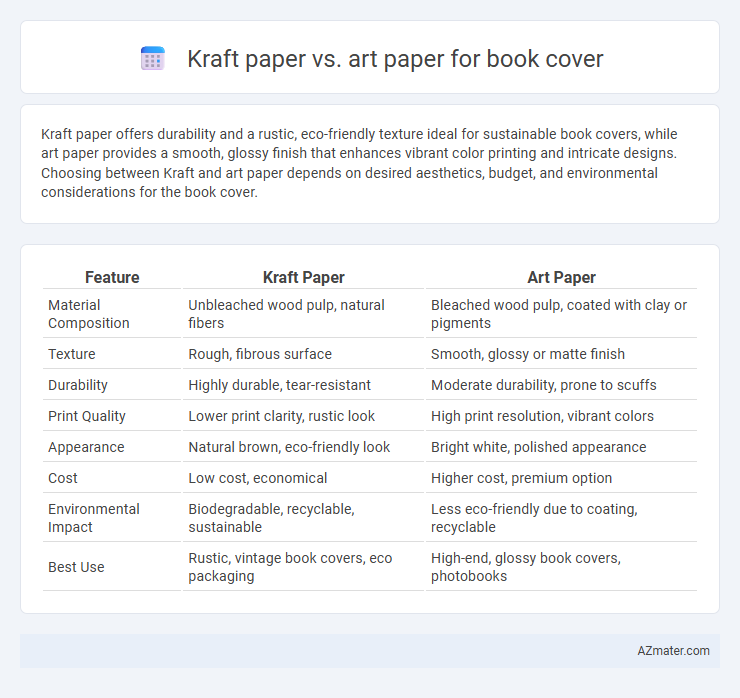Kraft paper offers durability and a rustic, eco-friendly texture ideal for sustainable book covers, while art paper provides a smooth, glossy finish that enhances vibrant color printing and intricate designs. Choosing between Kraft and art paper depends on desired aesthetics, budget, and environmental considerations for the book cover.
Table of Comparison
| Feature | Kraft Paper | Art Paper |
|---|---|---|
| Material Composition | Unbleached wood pulp, natural fibers | Bleached wood pulp, coated with clay or pigments |
| Texture | Rough, fibrous surface | Smooth, glossy or matte finish |
| Durability | Highly durable, tear-resistant | Moderate durability, prone to scuffs |
| Print Quality | Lower print clarity, rustic look | High print resolution, vibrant colors |
| Appearance | Natural brown, eco-friendly look | Bright white, polished appearance |
| Cost | Low cost, economical | Higher cost, premium option |
| Environmental Impact | Biodegradable, recyclable, sustainable | Less eco-friendly due to coating, recyclable |
| Best Use | Rustic, vintage book covers, eco packaging | High-end, glossy book covers, photobooks |
Introduction to Kraft Paper and Art Paper
Kraft paper, made from wood pulp through the kraft process, is known for its high durability, natural brown color, and eco-friendly properties, making it a popular choice for rustic or vintage-style book covers. Art paper, often coated and available in a variety of finishes like matte or glossy, offers a smooth surface ideal for high-quality printing and vibrant color reproduction, enhancing the visual appeal of book covers. Choosing between kraft paper and art paper depends on the desired aesthetic, durability requirements, and print quality for the book cover.
Key Characteristics of Kraft Paper
Kraft paper features high durability and tear resistance due to its unbleached, natural wood pulp composition, making it ideal for eco-friendly and rugged book covers. Its coarse texture and brown color offer a rustic, organic aesthetic that contrasts with the smooth, glossy finish of art paper. Kraft paper's strength and recyclability contribute to sustainable packaging and printing solutions in bookbinding.
Key Characteristics of Art Paper
Art paper features a smooth, glossy or matte finish that enhances printed colors and sharpness, offering high opacity and minimal show-through ideal for vibrant, high-quality book covers. It is coated with a layer of clay and pigments, providing excellent ink absorption and allowing for detailed, crisp images that stand out on covers. Its durability and resistance to aging ensure the book cover maintains visual appeal over time, making it a preferred choice for premium publications.
Aesthetic Appeal: Texture and Finish
Kraft paper offers a rustic, natural texture with a matte finish that enhances a vintage or eco-friendly aesthetic for book covers. Art paper provides a smooth, glossy or satin finish that emphasizes vibrant colors and sharp details, ideal for high-quality, visually striking designs. The choice between Kraft and Art paper significantly influences the tactile experience and visual impact of a book cover.
Durability and Protective Qualities
Kraft paper offers exceptional durability and tear resistance due to its dense fiber composition, making it ideal for protecting book covers against rough handling and environmental wear. Art paper, while providing a smooth and high-quality finish, is more susceptible to creasing and damage over time, especially under frequent use. For long-lasting protection, kraft paper's robustness and resistance to moisture make it a superior choice in preserving book covers.
Print Quality and Color Rendering
Kraft paper offers a rustic, textured finish ideal for eco-friendly book covers but has limited print quality and muted color rendering due to its uncoated surface. Art paper provides a smooth, coated finish that enhances print quality with sharp details and vibrant, accurate color reproduction, making it preferable for high-end, visually striking covers. Choosing between kraft and art paper depends on balancing the desired aesthetic with the need for bright, crisp imagery in book cover design.
Environmental Impact and Sustainability
Kraft paper is highly regarded for its environmental impact due to its biodegradable, recyclable, and often recycled content, making it a sustainable choice for book covers. Art paper, while providing superior print quality and aesthetics, typically involves more intensive chemical processing and less post-consumer recyclability, increasing its environmental footprint. Choosing kraft paper for book covers significantly reduces resource consumption and waste, aligning with eco-friendly publishing practices.
Cost Comparison: Kraft vs Art Paper
Kraft paper typically offers a more cost-effective solution for book covers compared to art paper due to its lower production and raw material expenses. Art paper, known for its smooth texture and high-quality print finish, usually incurs higher costs stemming from advanced coating processes and premium materials. Choosing Kraft paper can significantly reduce overall printing costs, making it ideal for budget-conscious publishing projects, while art paper offers superior aesthetics at a higher price point.
Best Use Cases for Book Covers
Kraft paper offers durability and a rustic, eco-friendly aesthetic, making it ideal for vintage-style notebooks, journals, and environmentally conscious publications. Art paper provides a smooth, high-quality surface perfect for vibrant color reproduction and detailed artwork, suitable for premium photo books, art catalogs, and high-end literary works. Choosing between kraft and art paper depends on the desired visual impact, tactile experience, and target audience of the book cover.
Final Considerations: Choosing the Right Paper
Kraft paper offers durability and a rustic aesthetic ideal for eco-friendly and vintage-themed book covers, while art paper provides a smooth finish with vibrant color reproduction perfect for high-quality imagery and detailed designs. The choice depends on the desired visual impact, texture, and target audience, with kraft paper excelling in tactile appeal and art paper favored for photographic or glossy covers. Evaluating factors such as print quality requirements, budget constraints, and brand alignment ensures the right paper enhances both form and function of the book cover.

Infographic: Kraft paper vs Art paper for Book cover
 azmater.com
azmater.com